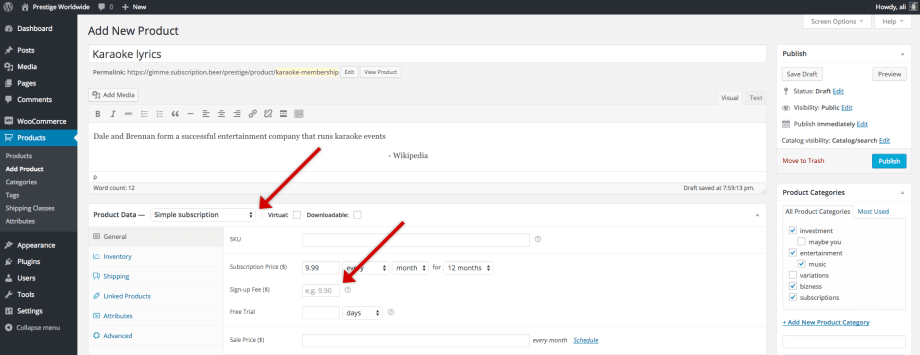Building an e-commerce store is essentially no different from building a physical storefront, except that it’s so much better, because, you know, no heavy lifting.
But just like a physical storefront, your website needs to sell product, and a lot of it, to be successful. If you have a one-of-a-kind product that’s so in demand people will literally send robots to wait in line for it, then you don’t really need to worry about anything we’re saying. You’re already doing great.
However, if you sell anything other than Apple iPhones, you’ll need to figure out how to sell your products on an ongoing basis. One of the best ways to do that is to turn your individual products into subscriptions.
Sweet, sweet subscriptions
When people think “subscriptions” they probably assume you mean subscribing to a magazine or a blog, which is certainly one way of offering cool content to your customers on a regular basis. But that’s not what we’re talking about.
We’re talking about commerce subscriptions, which allow customers to order the same products on a regular schedule. Commerce subscriptions have a few benefits over trying to sell individual products one at a time:
Subscriptions are extremely convenient, especially if you sell products people buy on the regular.
Click to tweet
First, commerce subscriptions are extremely convenient for customers, especially if you sell products that people buy on the regular. Think: Dollar Shave Club.

Source: Dollar Shave Club
Second, they are extremely convenient for your store, as you have the ability to scale as demands change. You also have a fairly predictable source of monthly income, which is always nice.
Subscriptions also work well to build brand loyalty, since customers are invested in your business on a continuous basis. All in all, if you can turn a product into a subscription, you should.
What sort of things can be turned into subscriptions?
Now you may be thinking, “My individual products don’t really work with subscriptions!” If that’s the case, maybe come up with a new product or service that does, because seriously, subscriptions are pretty much the best source of revenue for your business.
If you don’t want to spend time and energy developing a new product (fine, fine, we get it), here are some ways you can approach subscriptions without reinventing the wheel.
Offer a membership
Again, think about companies like Dollar Shave Club or Honest Company, which are membership-based commerce sites that make millions of dollars each year selling stuff you can find for a dollar at your local drug store. How do they do it? The power of exclusivity. Even if you sell something so extremely basic that everyone already has two at home, including a yearly membership that offers additional discounts to members is a great way to add income as well as provide a service for loyal customers.
Offer discounts for frequently ordered items
If a customer in any way will return to your site to reorder, offering a way to do it that both saves them money and makes you more money is a win-win solution. Amazon does this with their Subscribe & Save service, which lets customers select items to subscribe to and then set their quantity and schedule for delivery.

Source: Amazon
Box single items together
If you have individual items that you’re always trying to cross-promote, consider boxing them together and selling them as a subscription product. Think about companies like JustFab (valued at $109M) or BarkBox ($1.7M), which are made up solely of these box subscriptions. Even if your customers don’t like all of the products in the box, they’ll still buy the box because it’s a deal, and everybody loves a good deal.
Turn a service into a subscription
Or, if you’re a SaaS company and don’t deal with products, your company is ready-made for subscriptions. Think of companies like Dropbox and Salesforce, which are built around subscriptions for using their services (and also are worth billions, just FYI). If customers can in any way benefit from things that you offer, and you can charge those people on a regular basis for it, don’t hesitate.
Making subscriptions run smoothly in WooCommerce
So once you’ve (wisely) decided to make the move to subscriptions, let’s talk about the nitty-gritty of what you need to know to make them run smoothly in your WooCommerce site.
Setting up subscriptions (if you’re not really a developer, but are still in charge of the store)
The things you’ll need to know about when it comes to commerce subscriptions include:
- Creating your subscription products
- Creating discounts association with subscriptions
- Integrating payment gateways with subscription products
- Setting up shipping and billing periods
- Creating subscription account pages
- Inputting subscription shortcodes
- Setting up subscription emails
Sound like a lot? Okay, it might be. BUT that doesn’t mean it’s not worth it. Much of the documentation for these processes is already developed, and once the processes are set up they essentially run themselves.

Source: WooThemes
Or you could, you know, ask the experts.
Setting up subscriptions (if you’re a developer)
Of course, if you are a developer and you’ve been saddled with the task of building on subscriptions to your WooCommerce site because your boss read this article and thought it was a nifty idea (we’re sorry), then here is what you need to know. Again, the documentation for this is already available, so you can follow it step by step.
- Get the WooCommerce Subscription plugin.
- Choose a payment gateway. This is probably a no-brainer, as you’ll most likely use whatever payment gateway you already have set up for the rest of your products. But some gateway APIs don’t always support recurring billing, so double check that your gateway is capable of it. Stripe is easiest out of the box, or just use PayPal, maybe? (If using PayPal, make sure Reference Transactions are enabled.)
- Use filters to register gateway support. This is done by setting the ‘supports’ property of your gateway. More information can be found here (Step 1).
- Set up recurring payments, fees, and billing periods. Basically, all the stuff in the previous bullet points. All of this can be done through the API. More information can be found here (Step 2).
- Manage ongoing subscriptions. Subscription status will change over time as people renew, cancel, subscribe to new services, or change their subscription periods. You’ll probably want to use the WooCommerce Payment Gateway API in addition to the Subscriptions API to help manage these changes.
Sound reasonable? Don’t worry, once everything is set up, the API takes over and manages a lot of things automatically. You’ll still need to make changes and deal with any one-off issues that arise, but overall, it’s not as complicated as it seems.
Again, the overall process to setting up WooCommerce subscriptions is fairly well documented, so whether you’re a newbie developer or a code expert you’ll be able to navigate making the changes. For everything else involved with subscriptions, like how to set pricing and market to customers, the folks over at Zuora have some tips.

